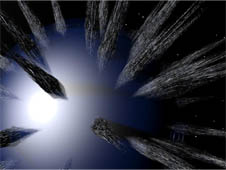Evolution
- Douglas Adams, The Hitchhiker's Guide to the Galaxy, 1980
Civilisations can evolve in four different ways, with many variations.
The first is the trivial: extinction. The species destroys itself, through war, environmental destruction, accidents or through memetic breakdown.
The second is stasis. The civilisation gradually evolves to a point where it does not change and resists most perturbations. It might still be dynamic, but the dynamics is within the bounds of the same attractor. The static state might be due to philosophy or simply a lack of species-level creativity. Static species might survive indefinitely, adapting to changes without leaving their mindset. The Trahans are an example of this way.
The third is transcendence. The civilisation develops to higher and higher levels of complexity and ability, eventually vanishing from the horizon of comprehensibility. This process is often divided into stages of increasing diversification and unification/synthesis. The solar system and possibly Ur-Mothers are examples of the transcendent approach.
The fourth is diversification. The civilisation branches out in all directions, changing and evolving. It might avoid transcendence or stasis indefinitely, or have parts enter these lines. Most of the human colonies and the Mothers are diversifying.
The current era is fairly quiet. Intelligent life is rare, most species never get anywhere, destroy themselves, become static or quietly transcend at home. The exceptions in the local area are the various Mother clans, the humans and the Trahans. Together they can likely change the destiny of this part of the galaxy.
